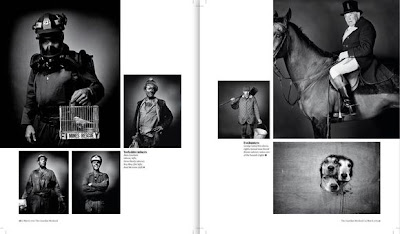Thomas was born in Cambridge in 1946 and studied at the Cambridge School of Art from 1962 - 67, specialising in illustration and printmaking. He then taught printmaking at Ipswich School of Art for twelve years; now, Thomas resides in the sleepy village of Capel St. Mary in Suffolk, working as a full-time artist. He has illustrated a number of books and is a Fellow of the Royal Society of Painter-Printmakers; at the Society's 1983 annual exhibition, his etching 'Honfleur', was awarded the Davys' prize for the best print.
Portraits
 |
| Glynn poses next to his traditional Victorian replica printing press. |
I felt that this shoot was far more successful than the one at the Pinkuah Arms last week - above are a few examples of the portraits I took using my DSLR (as with the previous shoot, I will not be able to view the film exposures until I return to University).
There was far better light in his studio than in the Pinkuah Arms, and the room was infinitely more photogenic. With Glynn I felt a lot more comfortable and a lot more confident in using the flash gun, I was also far more proficient in the positioning of the subject. Furthermore, I was far more aware of composition, spending more time on each shot - making sure I bracketed (when shooting on film) and taking the time to talk to Glynn between shots to create a more comfortable atmosphere. After about ten minutes I was shooting without doubt in my exposure or composition.
Above are my three favourite portraits taken on my digital camera - if I was to decide an ultimate favourite from the three similar frames, it would probably be the very top image, simply because of his more relaxed stance and the way I shot from below, giving a far more interesting composition.
I am particularly proud of these shots because I believe they are the first time I have managed to truly use the Metz flash to its fullest potential - the subject is well-lit by the flash, but not overpowered by it. To help create the softer light I covered the flash head with a piece of white clothe held in place with an elastic band, helping to create a nice tonal range and a softer light, with dark hues of brown, green and blue.
The final three portraits are of Glynn standing with his traditional Victorian replica printing press, which he uses to create his prints. I think these images are very successful, as they are well-lit and serve the purpose of environmental/formal portraits well. Again, I used the Metz flash with the make-shift soft box to create a more ambient light. Here, though, Glynn was also lit by light coming in through a window, which illuminated the scene nicely, picking up the details in his clothes and in the frame of the printing press.
All in all, I am very happy with the results of this shoot, and I can't wait to see how the films process. Next week I am heading to Manningtree for a portrait shoot at the sailing club there - I am exciting to continue using the Metz flash more and more to keep on improving my portraits.
S

























































